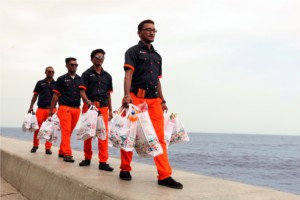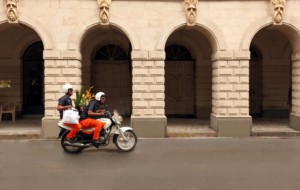From convenience purchases to convenience delivery — the entire practice of shopping and ordering products is undergoing a revolution. As families grow smaller and working professionals get more and more time-poor, convenience is increasingly becoming the anchor of any purchase.
One app which is striving hard to spread that gratification is Mumbai-based Scootsy. For the last one year, the company has been allowing customers to discover and get products delivered across a spectrum of categories ranging from restaurant food, gourmet food products to fashion, gifts, and essential goods.
With a strict mantra of conducting operations without going the discount way, Scootsy is working backward to get the delivery, packaging, technology and marketing aspects right to ensure a seamless front-end experience. Calling itself an intra-city app, the company has taken conscious steps to leave its mark in Mumbai before expanding to other cities.
Now, with one year of successful operations and 30 per cent month-on-month growth, the company eyes expansion and might close its first round of funding in the coming months.
Indiaretailing Bureau speaks with Managing Director, Rishi Khiani on how’s he doing it.
Take us through the Scootsy journey so far.
Scootsy started operations in July 2015. It came about as we found a gap in the delivery services market. There was no one delivering a broad selection of fast and quality good. It’s a quick curated one stop quality delivery service with everything from stationery and sushi to shoes and shot-glasses. It is the solution for busy, time-strapped urbanites that value instant gratification and convenience.
Scootsy essentially started as a food delivery app but went on to add other diversified categories. Why?
We started with food as we wanted to create a daily habit for the app, gradually moving on to other categories. For items like books, toys and gifts instant delivery is not something they are used to. For that it’s about changing typical consumer behavior but once they get used to it, they get addicted. The Harry Potter launch, for example, was a huge success, people saw the value for not waiting in line.
What is the contribution of food vs other categories on the platform?
Food still forms a large part of our business. This category is 70 per cent of the overall business. The remainder is split across other categories.
Online businesses have largely been riding on a discount-driven strategy in order to acquire customers. Scootsy, however, claims to be growing organically and not spending any money on discounts. How do you do it? Please elaborate.
We have a policy of not going down the discount route. Our carefully curated range of vendors is part of our marketing strategy. Brands like Th e Table, Le15 Patisserie, ROYCE’, Habbana, AND, Global Desi are exclusively with us. Our riders also act as brand ambassadors. Seeing them zipping around the city in bright orange has also helped create brand awareness. To add to this, we have partnered with events such as Nariyal Paani in Alibaug (for a speedboat service) and Food with Benefits (a 9 chef charity dinner including Rahul Akerkar, Pooja Dhingra, Kelvin Cheung, Alex Sanchez) providing unique experiences to our customers.
e Table, Le15 Patisserie, ROYCE’, Habbana, AND, Global Desi are exclusively with us. Our riders also act as brand ambassadors. Seeing them zipping around the city in bright orange has also helped create brand awareness. To add to this, we have partnered with events such as Nariyal Paani in Alibaug (for a speedboat service) and Food with Benefits (a 9 chef charity dinner including Rahul Akerkar, Pooja Dhingra, Kelvin Cheung, Alex Sanchez) providing unique experiences to our customers.
You have invested in your own delivery fleet, unlike others. How does it work both in terms of investment and management? Please explain.
We have bootstrapped it so far and our unit economics to ensure we survive a boom or bust. This way, we keep building on our user bases while remaining highly optimised. We have hubs across the city. Each hub is responsible for the delivery in their radius and they manage the riders. Additionally, while we pay for the riders, we don’t invest in the scooters as the riders we hire already have their scooters.
Unlike other delivery app, Scootsy has not been too aggressive on adding cities to its platform. Was this a conscious decision to grow slow? Yes, no, why? What is your expansion strategy?
Like any business, it is very important to ascertain how the market will react to your business. This is exactly what we have been doing in Mumbai – broadening our geographies across the city, scaling up our logistics, adding more riders, adding more verticals and getting the business and our deliveries near to perfect. While scaling and expansion is on the cards, we made a conscious decision to focus on Mumbai and become the city’s favourite app.
How many pin codes are you currently delivering to, how many orders do you cater to per day, what is the average ticket size?
We are doing 75,000 orders a month and our average ticket size is INR 900.
How has been the growth so far? What matrix are you looking to achieve this year?
We are growing 30per cent month on month.
Don’t you think the space is getting crowded? How far is saturation according to you?
I don’t think any other brand does what we do. Our USP is the fact that we are not just a delivery platform, but a discovery one too where we help customers get acquainted with newer brands. We are highly curated. To add to this, our deliveries happen within an hour or two, and not just for food but across categories.
Ant Farm is known for building few profitable ventures in the past. How do you look at profitability for Scootsy?
For us, Scootsy is a long term project. Our main aim is to focus our energies in creating value for the brand in the eyes of our customers as well as maintaining the profitability.
How do you plan to monetize? Are you a funded venture?
Ant Farm is funded and we are currently in advance talks with multiple partners for raising a round at Scootsy.
What according to you are the challenges ahead? What were the challenges you faced earlier in bringing the customers aboard?
The initial challenge was convincing vendors who were not equipped for delivery to get on board. We ended up working closely with a lot of vendors and almost working backwards in order for them to get the delivery menu and packaging right.
 From a tech and logistics perspective creating algorithms for delivery efficiencies was also another big challenge. However, once we had the product and tech in place, we also had to get consumers used to the concept of instant gratification in sectors other than food.
From a tech and logistics perspective creating algorithms for delivery efficiencies was also another big challenge. However, once we had the product and tech in place, we also had to get consumers used to the concept of instant gratification in sectors other than food.
Lastly, being boot-strapped was a challenge as we had to be conservative with our marketing spends. We focused on guerrilla marketing such as letting our uniformed riders in bright orange spread awareness for the brand. We also worked on getting exclusive vendors on board such as Le15 Patisserie, Suzette, The Table, Hamleys and ROYCE’ Chocolate. Looking forward the challenges will be recreating our success in other cities.
Ditching discounts, Scootsy scales growth with exclusive vendors, guerrilla marketing
From the last one year, the company is working backward to get the delivery, packaging, technology and marketing right to ensure a seamless front-end experience.
Must Read


